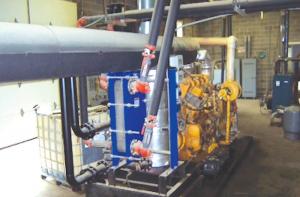Manure Digester Meets Dairy’s Needs
 ✖  |
The manure digester on Schrack Farms has paid for itself as a heat source for the multi-generation family dairy. For the past 18 years, the 200-kW generator has also been pumping out electricity as local rates have doubled to 14¢/kW. The big surprise has been the residual liquids’ benefits to the no-till/cover crop farming system (Vol. 48, No. 6).
“The ability to fertilize crops with the liquids has been a game changer for us,” says James Harbach, Schrack Farms. “The manure goes into the digester at a pH of 7, and the liquid nutrients come out with a pH of 8. We dribble it on our cover crops before harvesting as a feed source in the spring and then another application on the corn fields sometime after emergence and again at harvest after we have planted cover crops.”
The heat produced by the system was immediately beneficial. Waste heat from the motor and generator provides hot water for the dairy and the farmhouse. It also dries digested solids for bedding and provides in-floor heat for the parlor and the milk truck bay. Even the exhaust heat from the motor that burns the digester-produced gas is run through a heat exchanger producing 160-degree air to dry washcloths used to clean udders on the farm’s 1,300-cow milking herd.
“The entire digester system was designed to meet 100 percent of our heating needs,” says Harbach.
Electricity generation wasn’t immediately beneficial. One reason was the need to be tied to the grid.
“We produce at least as much energy as we use 97 to 98 percent of the time, but the other two to three percent, you need to be on the grid,” says Harbach.
Producing their own electricity and selling the excess to the power company has been challenging. “For the first four years, the utility was allowed to charge us a transition fee,” says Harbach. “We had to pay them for the power we had purchased in 2005, but no longer needed after installing our system. They classified us as a generator, causing them competition. That continued until 2010.”
In addition, for the first year and a half, they weren’t paid for the excess electricity produced over the farm’s needs because net metering laws weren’t yet in effect. After that, they were paid the wholesale rate for excess but charged the retail rate when buying energy.
Payback was further complicated after 2010, with fees and extra charges if the farm’s generator shut down and the farm drew power from the grid. When the farm went to three-phase power on a new facility, it became subject to high demand charges.
“If we took 220 power from the grid for 15 min. in any one-month billing period, we were charged for a month’s demand,” says Harbach. “We could get a $2,000 bill for only 15 min. of power.”
Another problem was that if the grid went down, the farm was required to shut down the generator and stop producing power.
Many of those complications will be in the past once the farm completes a planned upgrade. With over 150,000 hrs. on the old generator, it’ll be replaced by a larger one. Updated systems and a backup diesel-powered generator are also being added.
Over the past 24 years, the milking herd has increased from 600 to 1,300. While the digester was sized for the larger herd, the generator wasn’t. Excess gas produced from the increased manure had to be flared off.
“We’re installing a 425-kW generator on the digester and will be able to monitor gas production in the digester better,” says Harbach. “We hope to minimize, if not do away with, flared gas.”
The farm will also be able to eliminate buying power from the utility. They continue to be connected to the grid to sell excess power. However, if the grid goes down, the farm will be disconnected. The backup generator will kick in, and the digester system will continue to run, producing heat, electricity and liquid fertilizer for the farm.
Even with the power company complications, the initial decision to install a digester has been a good one. However, Harbach suggests anyone considering installing a system should research utility requirements in their area. Sizing the system for farm needs and utilizing both excess heat and electricity on farm is key.
While selling excess energy can help with the return on investment, rates and conditions can change over time. Harbach looks forward to a new level of independence from his power company.
“The new upgrade will allow us to stand alone,” says Harbach. “It’ll give us more options going forward to get away from high demand charges while still satisfying our heat and energy needs, not to mention crop nutrient needs.”
Contact: FARM SHOW Followup, Schrack Farms, 860 W. Valley Rd., Loganton, Penn. 17747 (jamesharbach@hotmail.com).

Click here to download page story appeared in.
Click here to read entire issue
Manure Digester Meets Dairy’s Needs DAIRY EQUIPMENT & IDEAS The manure digester on Schrack Farms has paid for itself as a heat source for the multi-generation family dairy For the past 18 years the 200-kW generator has also been pumping out electricity as local rates have doubled to 14¢/kW The big surprise has been the residual liquids’ benefits to the no-till/cover crop farming system Vol 48 No 6 “The ability to fertilize crops with the liquids has been a game changer for us ” says James Harbach Schrack Farms “The manure goes into the digester at a pH of 7 and the liquid nutrients come out with a pH of 8 We dribble it on our cover crops before harvesting as a feed source in the spring and then another application on the corn fields sometime after emergence and again at harvest after we have planted cover crops ” The heat produced by the system was immediately beneficial Waste heat from the motor and generator provides hot water for the dairy and the farmhouse It also dries digested solids for bedding and provides in-floor heat for the parlor and the milk truck bay Even the exhaust heat from the motor that burns the digester-produced gas is run through a heat exchanger producing 160-degree air to dry washcloths used to clean udders on the farm’s 1 300-cow milking herd “The entire digester system was designed to meet 100 percent of our heating needs ” says Harbach Electricity generation wasn’t immediately beneficial One reason was the need to be tied to the grid “We produce at least as much energy as we use 97 to 98 percent of the time but the other two to three percent you need to be on the grid ” says Harbach Producing their own electricity and selling the excess to the power company has been challenging “For the first four years the utility was allowed to charge us a transition fee ” says Harbach “We had to pay them for the power we had purchased in 2005 but no longer needed after installing our system They classified us as a generator causing them competition That continued until 2010 ” In addition for the first year and a half they weren’t paid for the excess electricity produced over the farm’s needs because net metering laws weren’t yet in effect After that they were paid the wholesale rate for excess but charged the retail rate when buying energy Payback was further complicated after 2010 with fees and extra charges if the farm’s generator shut down and the farm drew power from the grid When the farm went to three-phase power on a new facility it became subject to high demand charges “If we took 220 power from the grid for 15 min in any one-month billing period we were charged for a month’s demand ” says Harbach “We could get a $2 000 bill for only 15 min of power ” Another problem was that if the grid went down the farm was required to shut down the generator and stop producing power Many of those complications will be in the past once the farm completes a planned upgrade With over 150 000 hrs on the old generator it’ll be replaced by a larger one Updated systems and a backup diesel-powered generator are also being added Over the past 24 years the milking herd has increased from 600 to 1 300 While the digester was sized for the larger herd the generator wasn’t Excess gas produced from the increased manure had to be flared off “We’re installing a 425-kW generator on the digester and will be able to monitor gas production in the digester better ” says Harbach “We hope to minimize if not do away with flared gas ” The farm will also be able to eliminate buying power from the utility They continue to be connected to the grid to sell excess power However if the grid goes down the farm will be disconnected The backup generator will kick in and the digester system will continue to run producing heat electricity and liquid fertilizer for the farm Even with the power company complications the initial decision to install a digester has been a good one However Harbach suggests anyone considering installing a system should research utility requirements in their area Sizing the system for farm needs and utilizing both excess heat and electricity on farm is key While selling excess energy can help with the return on investment rates and conditions can change over time Harbach looks forward to a new level of independence from his power company “The new upgrade will allow us to stand alone ” says Harbach “It’ll give us more options going forward to get away from high demand charges while still satisfying our heat and energy needs not to mention crop nutrient needs ” Contact: FARM SHOW Followup Schrack Farms 860 W Valley Rd Loganton Penn 17747 jamesharbach@hotmail com
To read the rest of this story, download this issue below or click
here to register with your account number.







